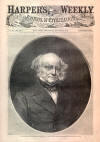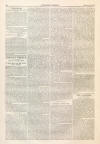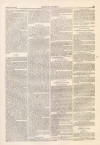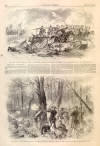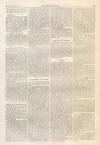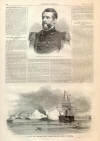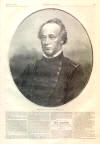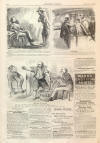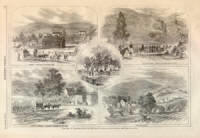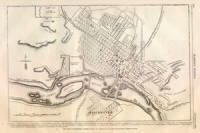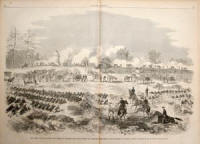General Keyes
|
|
This Site:
|
HARPER'S WEEKLY. [AUGUST 9, 1862. 508 BRIGADIER GENERAL KEYES, U.S.A.—[PHOTOGRAPHED BY BRADY.]BRIG.-GENERAL KEYES, U.S.A.WE publish on this page a portrait of GENERAL ERASMUS D. KEYES, commanding the Fifth Army Corps in the Army of the Potomac. General Keyes was born in Massachusetts about the year 1812, and entered West Point from that State in 1828. In 1832 he graduated and entered the Third Artillery, in which he served till 1837, when he became a member of General Scott's military family. In the following year he was appointed Assistant Adjutant-General. In 1841 he obtained his company, which he commanded for three years, after which he assumed the post of Instructor of Cavalry and Artillery at West Point. He remained in this position during the Mexican War. At the outbreak of the rebellion General Keyes was one of the first officers to whom the Government looked for aid. On 14th May, 1861, he was appointed Colonel of the Eleventh Infantry—one of the new Regiments; and, three days afterward, Brigadier-General of Volunteers. He served in the Army of the Potomac under General McDowell, and afterward, when the army was subdivided and reorganized under General McClellan, he obtained command of a corps d'armee. He is regarded as one of the most efficient officers in the Army of the Potomac. THE REBEL IRON-CLAD "ARKANSAS."WE publish herewith an illustration, from a sketch by Mr. Theodore R. Davis, representing the REBEL IRON-CLAD STEAMER "ARKANSAS" RUNNING THROUGH OUR FLEET FROM THE MOUTH OF THE YAZOO RIVER TO THE PROTECTION OF THE BATTERIES AT VICKSBURG. The feat was equally glorious to the rebels as it was mortifying to us. After describing how the Arkansas was discovered in the Yazoo River, and Captain Walke had dispatched the Tyler to warn the fleet, the Herald correspondent says: As the Tyler was turning to head down the Yazoo in the direction of the fleet, the Carondelet opened upon the Arkansas with her bow guns. She did but little injury, as the heavy plating of the Arkansas glanced off most of the shots and sent them at a tangent flying through the air. Three rounds were fired from these bow guns, making nine separate missiles, two or three of which are supposed to have taken effect, as the sides of the rebel boat appeared to be perforated in many places, and the contiguous plates somewhat loosened. After these had been fired the Carondelet came up to the Arkansas broadside on, discharging her guns with the greatest rapidity possible. The Arkansas, in return, used her rifled and smooth-bore guns with telling effect, the two and a half inch plating offering generally but little resistance to the heavy projectiles sent against it. The sides and casemating of the Carondelet were repeatedly perforated, some of the shot going entirely through and passing out on the opposite side. Two men were killed by a shot and three wounded by splinters. Though sadly riddled, the Carondelet was not struck below the water-line, nor was her machinery injured. She will be in proper trim again in a short time. The Carondelet at length succeeded in getting alongside and grappling the Arkansas. The order "Boarders away" was instantly passed, and the crew of the Yankee gun-boat speedily mounted the deck of its adversary. When there they found no foe to engage, and looked around for somebody or something to fight. The crew of the Arkansas had retired below, and the iron hatches were closed and fastened beneath, so that it was utterly impossible to go down and continue the action. The men of the Carondelet were much in the condition of one who attempts to open an oyster, but has neither knife, scissors, nor stone with which to perform the operation. Rifle and pistol shots annoyed them from various loopholes, and hot water and steam were sent forth from the pipes of the Arkansas, while the guns of the rebel continued to play against the comparatively frail sides of the Carondelet. The Carondelet replied with her steam apparatus, and this kind of fighting might have continued till both were exhausted had not the vessels struck bottom, by which the grapplings were loosed and the Arkansas allowed to drift down the stream, leaving the Carondelet by the shore. To the surprise of those on the latter boat, the Arkansas did not renew the battle, but put on all steam and moved slowly down the river. The Tyler succeeded in reaching the fleet nearly half an hour in advance of the Arkansas. thus giving a little time to prepare for the reception of the visitor. None of the boats had much steam up, though all had fires in their furnaces. Instantly the utmost efforts were made to get the boats ready to manoevre in case the Arkansas should really make an attack. But two or three were able to move at the time the Arkansas appeared around the bend, though the fires were "crowded" as much as possible. The Louisville and Cincinnati succeeded in getting their wheels in motion and hoisting anchor, and the Benton had just swung from her moorings. The Cairo was doing her best, and the rams were prompt to perceive the exigencies of the occasion and make ready for an onset. The vessels of Commodore Farragut's squadron beat to quarters, and determined to receive the enemy while at anchor. As the Arkansas approached she encountered gunboat No. 6 of Farragut's fleet, carrying one heavy 11-inch Dahlgren and two small 12-pounders at the bow. This boat received several shots from the Arkansas, and replied vigorously with her big gun, sending one ball through the side of the latter. Without stopping her engines the Arkansas ran past No. 6, and next encountered the Louisville, which gave her the full benefit of her broadside and bow guns. The Arkansas had by this time reached a position where her shot were effective in every direction, and she used all her guns at the same moment, firing at transports and gun-boats indiscriminately. None of the boats were able to give the Arkansas more than one or two broadsides before she was out of reach. Most of the balls were thrown at short range, but many of the solid projectiles glanced off, while the shells were shivered into a thousand fragments by the force of the concussion alone. The Benton, Louisville, and Cincinnati moved as speedily as they could turn in the river, and followed closely upon the heels of the Arkansas. As the rebel boat passed the Hartford, Iroquois, and Richmond she received a heavy broadside from each. The Essex, which arrived only a few days since, managed to send two 100-pound steel shot fairly through the sides of the Arkansas, cawing her to careen fearfully. One of them is thought to have struck near her water-line and caused her to leak badly, as she kept her pump constantly going, and poured out a large stream of water from her sides. One of the Richmond's 100-pound Parrott shot is also supposed to have gone completely through her. After each discharge of her guns the port-holes of the Arkansas were instantly closed, her sides presenting nothing but a mass of almost impenetrable wood and iron. One of those port-holes was left open fora moment, and a ball from the Benton entered, killing ten men and wounding several others. A shot from one of the boats, at short range, is said to have struck at right angles upon the side of the Arkansas, and rebounded, falling into the water close to the vessel from which it was discharged. The Arkansas did not slacken her speed during her progress down the river, but kept steadily forward, firing her guns as she moved ahead. Her speed of motion is not as great as some of her friends have thought she would attain, her immense weight causing her to draw too much water for rapid movements. Her enormous iron prow was prominent to view; but she did not attempt to use it upon any of the boats after the first attack. This was probably owing to her slow pace, and it is to her failure in this respect that we are doubtless indebted for the present safety of our boats. The ram Lancaster, No. 3, at one time started for the Arkansas, intending to run her down; but before proceeding far she received three shots, one of which severed her steam-pipe, by which a number of her crew were severely scalded, two of them fatally. Notwithstanding the great number of boats opposed to her, the Arkansas succeeded in passing safely through and seeking the protection of the rebel batteries. THE NEW COMMANDER-IN-CHIEF.WE give on the next page a portrait of MAJOR-GENERAL HENRY W. HALLECK, who was appointed on the 11th ult. Commander-in-Chief of the Armies of the United States. Henry Wager Halleck was horn at Weston, Oneida County, New York, in 1820, and is consequently forty-two years of age. He entered West Point in 1835, graduated third in his class, and obtained a commission in the engineers. For a year he served as assistant professor of engineering at West Point. From 1810 to 1815 he diversified his military duties by lecturing; He likewise published one or two important scientific and military works. When the war with Mexico broke out he was in California, and for conduct in skirmishes there in November, 1847, he was brevetted Captain. He was subsequently chief of Commodore Shubrick's staff, Secretary of State of California, and, in 1849, a member of the Convention which drafted the Constitution of the State. He took such a liking to the Pacific coast that its 1854, being then Captain of Engineers, he resigned his rank, studied law, and opened an office in San Francisco. His firm, Halleck, Billings, & Co., were very successful at the has. It is a little curious that one of the first business transactions in which General Halleck was engaged when he went to St. Louis to command the department of the West, was a private pecuniary matter in which he acted as the legal adviser of his old client, Major-General Fremont—whom, in effect, he came to supersede. When the rebellion broke out, General Halleck was at once summoned front California by the Government, at the instance of General Scott, and appointed to the command front which Fremont had been removed, and which General Hunter had temporarily filled. His administration has been a series of brilliant triumphs. When he arrived at St. Louis the rebels held all Tennessee, most of Kentucky, and three-fourths of Missouri; the Mississippi was blockaded to within twenty miles of Cairo; secession was rampant and loyalty at a discount. General Halleck began by hanging bridge-burners, which put a stop to the destruction of bridges; he next made the secession sympathizers pay the losses of Union men who had been robbed by the rebels; this put an end to rebel outrages on Unionists and cooled the wealthy traitors of St. Louis. Then moving his armies and his gun-boats in a methodical manner, he expelled the rebels from Missouri and Northern Arkansas, took Fort Henry, Fort Donelson, and Island No. 10; compelled the evacuations successively of Bowling Green, Columbus, Corinth, and Cumberland Gap; and now enables his soldiers to rest on their arms during the hot months—having nearly completed the work they were set to do. He has hardly met (Next Page) THE REBEL RAM "ARKANSAS" RUNNING THROUGH THE UNION FLEET OFF VICKSBURG.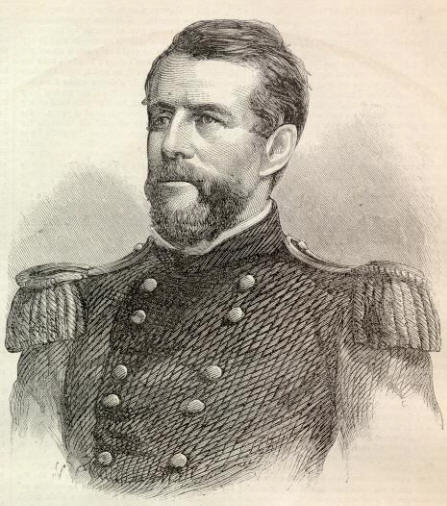 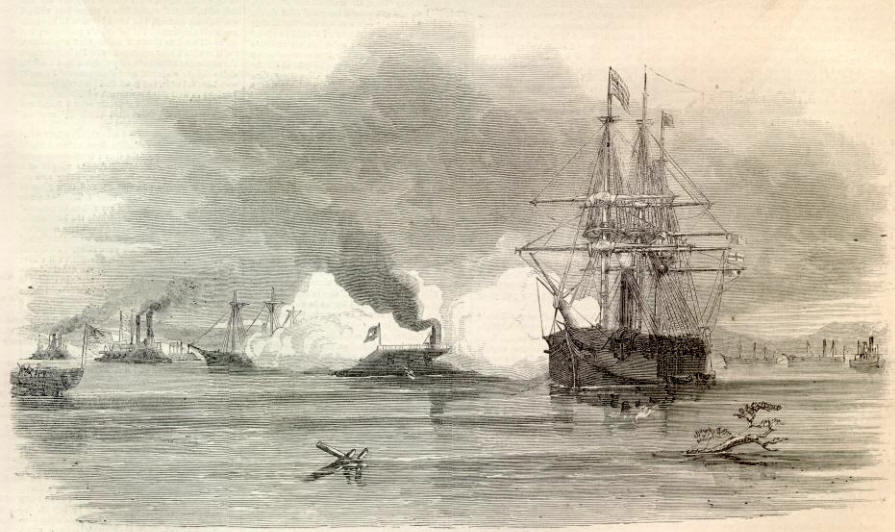 |
||||||||||||||||||||||
|
|
||
|
|
Site Copyright 2003-2018 Son of the South. For Questions or comments about this collection, contact paul@sonofthesouth.net |
|
|
Are you Scared and Confused? Read My Snake Story, a story of hope and encouragement, to help you face your fears. |
||
